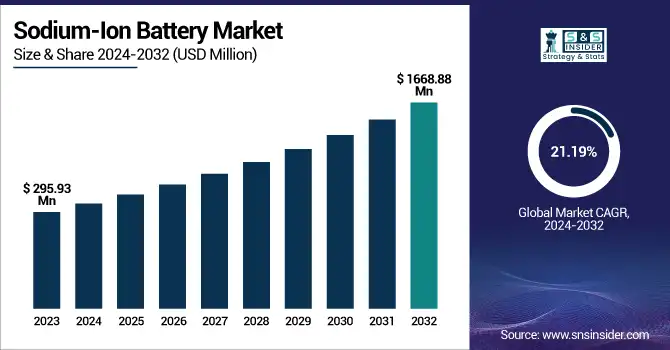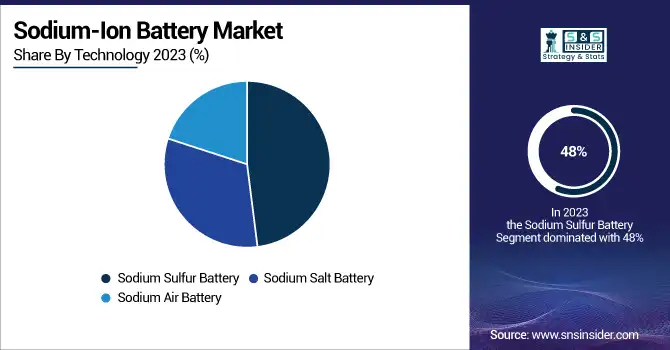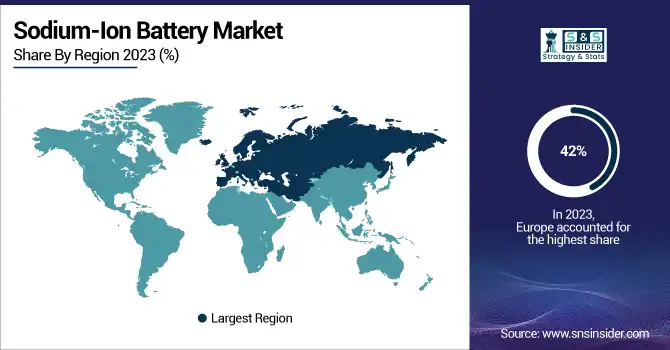Sodium-Ion Battery Market Report Scope & Overview:
The Sodium-Ion Battery Market Size was estimated at USD 295.93 million in 2023 and is expected to arrive at USD 1668.88 million by 2032 with a growing CAGR of 21.19% over the forecast period 2024-2032. The report provides a unique perspective on the Sodium-Ion Battery Market by analyzing production output trends and capacity utilization rates across key regions, highlighting the industry's efficiency and scalability. It delves into R&D investments and patent filings, showcasing innovation hubs and emerging technological breakthroughs. The study also tracks adoption rates of new advancements, indicating the pace of commercialization. Additionally, export/import trends reveal global trade dynamics shaping supply chains.

To Get more information on Sodium-Ion Battery Market - Request Free Sample Report
The U.S. Sodium-Ion Battery Market is projected to grow from USD 34.56 million in 2023 to USD 194.02 million by 2032, at an impressive CAGR of 21.13%. This rapid expansion is driven by increasing demand for grid energy storage, as sodium-ion batteries offer a cost-effective alternative to lithium-ion solutions, driven by growing demand across multiple sectors. Industries such as electric utilities, transportation, and industrial energy storage are increasingly adopting sodium-ion batteries due to their cost-effectiveness, abundance of raw materials, and promising energy storage capabilities.
Sodium-Ion Battery Market Dynamics
Drivers
-
The growing need for cost-effective energy storage for renewable integration is driving sodium-ion battery adoption, supported by advancements, investments, and expanding commercialization.
The rising demand for energy storage solutions, particularly for renewable energy integration, is accelerating the adoption of sodium-ion batteries. As the world transitions to clean energy sources like solar and wind, effective storage systems are key to tackling intermittency and keeping the lights on. That's high compared to lithium, but sodium is an abundant and inexpensive alternative to lithium-ion batteries. Moreover, these batteries offer a scalable solution for energy security and sustainability in a grid storage application. Investment in research and development in the sodium-ion battery market is accelerating, which is resulting in the improvement of energy density and cycle life. Major players are concentrating on commercializing sodium-ion technology for large-scale energy storage and low-cost EVs. Governments and private entities are also playing a role in the adoption of sodium-ion battery technology, offering policies to encourage its deployment and funding initiatives. As a result, the market for sodium-ion batteries is expected to keep growing, especially as manufacturing capacity increases.
Restraint
-
Sodium-ion batteries have lower energy density than lithium-ion batteries, limiting their use in high-performance and compact applications.
Sodium-ion batteries face a significant limitation due to their lower energy density compared to lithium-ion batteries. Energy density defines how much energy a battery can store for its total weight or volume, the higher it is, the more efficient and higher range the battery will be, hence the importance of energy density to a battery. Sodium-ion batteries have energy densities of 100–160 Wh/kg, but lithium-ion batteries can top 250 Wh/kg. This energy density gap constrains the use of sodium-ion batteries in applications that demand high energy storage, including long-range electric vehicles and high-performance consumer electronics. This leads to larger and heavier battery packs and lower efficiency and practicality for weight-sensitive applications. Continued research and improved electrode materials, like layered oxides and Prussian blue analogs, will seek to improve energy density. Sodium-ion technology could be ideal for stationary energy storage and cost-sensitive applications, but this challenge must be addressed for it to penetrate competitive markets.
Opportunities
-
Strategic partnerships and investments in sodium-ion battery startups are driving innovation, commercialization, and market expansion.
Strategic partnerships and investments are playing a crucial role in accelerating the growth of the sodium-ion battery market. As the need for affordable and sustainable energy storage solutions grows, there is a rising tide of funding for sodium-ion battery startups coming from venture capital firms, government initiatives, and major energy companies. Those investments are helping fuel progress in battery chemistry, manufacturing scale-up, and supply chain development. Partnerships among battery manufacturers, automotive companies, and renewable energy firms are driving technological advancements, speeding up commercialization, and increasing competitiveness in the market. Research institutions are entering joint ventures with industry leaders to tackle technical challenges, like increasing energy density and cycle life. As the sodium-ion approach grows, partnerships will create a scale favorable to lower costs of production and broaden application in electric cars, grid storage, and consumer electronics.
Challenges
-
Further R&D is essential to enhance sodium-ion battery energy density, charging efficiency, and cycle life for widespread commercial adoption.
Performance optimization is crucial for the commercial adoption of sodium-ion batteries, as they currently lag behind their lithium-ion counterparts in key metrics like energy density, charging efficiency, and cycle life. Research & Development are conducted on the improvement of the electrode materials which includes high-capacity cathodes and stable anodes to optimize the total battery performance. Researchers are also experimenting with new electrolytes and solid-state designs to improve efficiency and slow down degradation over cycle life. Primary and secondary process optimization plays a crucial role in standardizing a manufacturing process (e.g., either top-down or bottom-up) that can be easily adapted and scaled to competitive levels to make sodium-ion batteries viable for conventional applications such as electric vehicles, grid storage, and consumer electronics. Partnerships between sodium-ion producers, research centers, and government agencies can speed development and help drive sodium-ion technology closer to commercialization. Developing sodium-ion batteries has proven difficult so far, but the current generational paradigm shift is making them a more feasible replacement for lithium-ion variants under development, offering a cost-effective, sustainable, and scalable energy storage solution for a wide range of industries.
Sodium-Ion Battery Market Segmentation Analysis
By Technology
The Sodium Sulfur Battery segment dominated with a market share of over 48% in 2023, due to greater energy density, long cycle life & a well-established presence in grid energy storage. The batteries would last long, discharge deeply, and be efficient, operating at high temperatures and using molten sodium and sulfur as the active materials. It is suitable for energy dispatch, frequency regulation, peak clipping and valley filling, and renewable energy grid connection due to its unique advantages of long service life and stable energy output. These pioneers in the industry also have increasingly better thermal management and material stability increasing performance and safety, making their position on the market even stronger. As the need for large-scale energy storage solutions increases, Sodium Sulfur batteries remain a go-to technology for utility-scale applications and industrial energy storage systems.

By End-Use
The Energy Storage segment dominated with a market share of over 44% in 2023, primarily due to the increasing reliance on renewable energy sources such as solar and wind power. Since these sources of energy are intermittent, this makes the technology of energy storage systems very important, as it is essential for providing a steady flow of power. Sodium-ion batteries are a more affordable and sustainable solution to lithium-ion batteries, with plenty of raw materials and increased safety. Utilities and grid operators are pouring money into sodium-ion technology to improve resilience in the grid and to support megawatt-scale energy storage projects. On top of that, supportive government policies encouraging clean-energy transitions along with fast progress in sodium-ion battery technology are speeding up adoption. The demand for high-performance, eco-friendly, and scalable energy storage solutions is driving the growth of this segment.
Sodium-Ion Battery Market Regional Outlook
Europe region dominated with a market share of over 42% in 2023, due to its strong regulatory framework, sustainability goals, and technological advancements. The European Union's support battery innovation and the energy transition have motivated them to invest heavily in research and development. Meanwhile, major battery producers and start-ups in Germany, France, and the UK are advancing sodium-ion technology for energy density, safety, and cost. Then Europe’s recent decoupling drive for battery localization and reducing the reliance on lithium-ion has also quickly diversified the development of sodium-ion gigafactories. Partnerships between research institutions and industry players reinforce the region’s leadership. With increasing interest in sustainable energy storage solutions, Europe continues to be a leader in overall sodium-ion battery commercialization and large-scale adoption.
Asia-Pacific is emerging as the fastest-growing region in the Sodium-Ion Battery Market, driven by rapid industrialization and the rising need for efficient energy storage solutions. Countries such as China and India are leading the way with high-volume manufacturing capacity and government-backed programs to increase output. The region already has repeatedly large calls for the integrated of an additional eight, tied to its strong focus on renewable energy integration, and the view of such an alternative as a low-cost, high-performance battery substitute would help drive expansion as well. With ongoing research and development to improve sodium-ion specifically focusing on energy density, cycle stability, cost, and more these technologies are being put forward as a solid candidate for electric car batteries and storage systems in the future. Promulgation of strong domestic and international player alliances through further supply-chain strengthening, and the presence of many researchers and, hence, sodium-ion battery innovators/adopters in Asia-Pacific are leading this region to become a major hotspot for sodium-ion battery technology vectors.

Get Customized Report as per Your Business Requirement - Enquiry Now
Key Players
-
Faradion Limited (Sodium-Ion Battery Cells & Energy Storage Solutions)
-
AMTE Power Plc (Sodium-Ion Battery Packs & Energy Storage Systems)
-
Natron Energy, Inc. (Sodium-Ion Batteries for Industrial & Data Center Applications)
-
Altris AB (Sodium-Ion Cathode Materials & Battery Solutions)
-
Tiamat Energy (Sodium-Ion Battery Cells for Mobility & Stationary Storage)
-
Li-FUN Technology Corporation Limited (Sodium-Ion Battery Modules & Cells)
-
Contemporary Amperex Technology Co. Limited (CATL) (Sodium-Ion Battery Systems & EV Batteries)
-
HiNa Battery Technology Co., Ltd (Sodium-Ion Batteries for Electric Vehicles & Energy Storage)
-
Indigenous Energy Storage Technologies Pvt. Ltd. (Indi Energy) (Sodium-Ion Battery Cells & Anode Materials)
-
Aquion Energy (Sodium-Ion Batteries for Renewable Energy Storage)
-
NEI Corporation (Sodium-Ion Battery Materials & Electrolytes)
-
Zhongke Haina Technology (Sodium-Ion Battery Cells & Grid Storage Solutions)
-
EnerVenue (Sodium-Based Energy Storage Solutions for Grid Applications)
-
Sinopoly Battery Limited (Sodium-Ion Batteries for Electric Mobility & Industrial Applications)
-
BYD Company Limited (Sodium-Ion Batteries for Stationary Storage & EVs)
-
Northvolt AB (Sodium-Ion Battery Technology for Energy Storage Systems)
-
EVE Energy Co., Ltd. (Sodium-Ion Battery Cells & Power Solutions)
-
BlueSky Energy (Sodium-Ion Batteries for Off-Grid & Residential Storage)
-
Pacific Northwest National Laboratory (PNNL) (Sodium-Ion Battery Research & Prototypes)
-
Zhejiang Huayou Cobalt Co., Ltd. (Sodium-Ion Battery Materials & Components)
Suppliers for (Sodium-ion batteries with fast-charging capabilities, targeting mobility and energy storage) on the Sodium-Ion Battery Market
-
HiNa Battery Technology Co., Ltd.
-
Faradion Limited
-
Altris AB
-
AMTE Power PLC
-
Contemporary Amperex Technology Co., Limited (CATL)
-
Natron Energy Inc.
-
Tiamat
-
Aquion Energy
-
Ionic Materials
-
Nexeon
Recent Development
In May 2024: Altris and Clarios entered a Joint Development Agreement to advance sodium-ion battery (SIB) technology for low-voltage mobility applications. Altris will focus on developing sodium-ion cells, while Clarios will contribute its expertise in Battery Management Systems, software, and system integration to create a complete battery solution.
In November 2023: Swedish battery manufacturer Northvolt announced a breakthrough in sodium-ion battery technology, achieving an energy density of 160 watt-hours per kilogram, comparable to some lithium iron phosphate (LFP) batteries.
| Report Attributes | Details |
|---|---|
| Market Size in 2023 | USD 295.93 Million |
| Market Size by 2032 | USD 1668.88 Million |
| CAGR | CAGR of 21.19% From 2024 to 2032 |
| Base Year | 2023 |
| Forecast Period | 2024-2032 |
| Historical Data | 2020-2022 |
| Report Scope & Coverage | Market Size, Segments Analysis, Competitive Landscape, Regional Analysis, DROC & SWOT Analysis, Forecast Outlook |
| Key Segments | •By Technology (Sodium Sulfur Battery, Sodium Salt Battery, Sodium Air Battery) •By End-Use (Consumer Electronics, Automotive, Industrial, Energy Storage, Others) |
| Regional Analysis/Coverage | North America (US, Canada, Mexico), Europe (Eastern Europe [Poland, Romania, Hungary, Turkey, Rest of Eastern Europe] Western Europe] Germany, France, UK, Italy, Spain, Netherlands, Switzerland, Austria, Rest of Western Europe]), Asia Pacific (China, India, Japan, South Korea, Vietnam, Singapore, Australia, Rest of Asia Pacific), Middle East & Africa (Middle East [UAE, Egypt, Saudi Arabia, Qatar, Rest of Middle East], Africa [Nigeria, South Africa, Rest of Africa], Latin America (Brazil, Argentina, Colombia, Rest of Latin America) |
| Company Profiles | Faradion Limited, AMTE Power Plc, Natron Energy, Inc., Altris AB, Tiamat Energy, Li-FUN Technology Corporation Limited, Contemporary Amperex Technology Co. Limited (CATL), HiNa Battery Technology Co., Ltd, Indigenous Energy Storage Technologies Pvt. Ltd. (Indi Energy), Aquion Energy, NEI Corporation, Zhongke Haina Technology, EnerVenue, Sinopoly Battery Limited, BYD Company Limited, Northvolt AB, EVE Energy Co., Ltd., BlueSky Energy, Pacific Northwest National Laboratory (PNNL), Zhejiang Huayou Cobalt Co., Ltd. |

